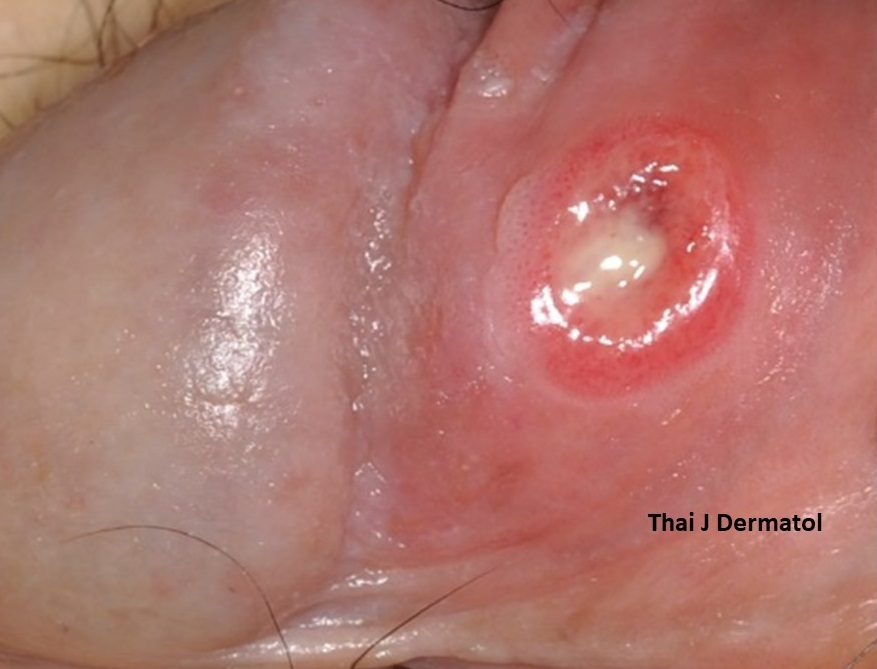A Presentation of Chancre Redux in An HIV-Infected Patient
Keywords:
Chancre redux, monorecidive syphilis, syphilis in HIVAbstract
Syphilis has been a major challenge in dermatology due to its various presentations and the fact that it’s a great imitator of multiple diseases. One of the cutaneous manifestations occurring in the primary stage is typically described as a solitary, painless, clean-based ulceration with elevated border. Here by, we report a case of syphilis with genital ulcer in an HIV-infected patient after receiving treatment. Chancre redux from inadequate treatment or recurrent infection should be included in the differential diagnosis. Occasionally, a cutaneous lesion of syphilis appears with an atypical character, especially in immunocompromised patient. In this situation, differential diagnosis should be carefully made, because mistaken medical assumptions could easily happen.
References
Syphilis Division of STD Prevention, National Center for HIV/AIDS, Viral Hepatitis, STD, and TB Prevention, Centers for Disease Control and Prevention [updated 4 June; cited 2020 2 November]. Available from: https://www.cdc.gov/std/tg2015/syphilis.htm.
Seña AC, Zhang X-H, Li T, et al. A systematic review of syphilis serological treatment outcomes in HIV-infected and HIV-uninfected persons: rethinking the significance of serological non-responsiveness and the serofast state after therapy. BMC Infectious Diseases 2015;15:479.
Thienkrua W, van Griensven F, Mock PA, Dunne EF, Raengsakulrach B, Wimonsate W, et al. Young Men Who Have Sex with Men at High Risk for HIV, Bangkok MSM Cohort Study, Thailand 2006-2014. AIDS Behav 2018;22:2137-46.
Leeyaphan C, Jiamton S, Prasertworonun N, Maneeprasopchoke P, Omcharoen V. Clinical and epidemiological characteristics of patients with syphilis: 5 year-case study from Thailand. J Med Assoc Thai 2014;97:963-8.
Centers for Disease Control and Prevention (CDC). HIV and syphilis infection among men who have sex with men--Bangkok, Thailand, 2005-2011. MMWR Morb Mortal Wkly Rep 2013;62:518-20.
Sewon K MA, Anna LB, Alexander HE, David JM, Amy JM, et al. . Fitzpatrick's dermatology 9th ed. New York: McGraw-Hill Education; 2019.
Steiner A, Battegay M, Greminger P, Lüthy R. HIV-Infektion und Lues. Fallbeschreibung und Literaturübersicht [HIV infection and syphilis. Case description and literature review]. Schweiz Med Wochenschr 1991;121:67-71.
Stokes Jh, Beerman H, Ingraham NR. Modern clinical syphiology. 3rd end. Philadelphia: WB Saunders, 1946;646.
Zetola NM, Klausner JD. Syphilis and HIV infection: an update. Clin Infect Dis 2007; 44: 1222-8.
Dombrowski JC, Celum C, Baeten J. Syphilis. The Travel and Tropical Medicine Manual 2017;535-44.

Downloads
Published
How to Cite
Issue
Section
License
เนื้อหาและข้อมูลในบทความที่ลงตีพิมพ์ในวารสารโรคผิวหนัง ถือเป็นข้อคิดเห็นและความรับผิดชอบของผู้เขียนบทความโดยตรงซึ่งกองบรรณาธิการวารสาร ไม่จำเป็นต้องเห็นด้วย หรือร่วมรับผิดชอบใดๆ
บทความ ข้อมูล เนื้อหา รูปภาพ ฯลฯ ที่ได้รับการตีพิมพ์ในวารสารโรคผิวหนัง ถือเป็นลิขสิทธิ์ของวารสารฯ หากบุคคลหรือหน่วยงานใดต้องการนำทั้งหมดหรือส่วนหนึ่งส่วนใดไปเผยแพร่ต่อหรือเพื่อกระทำการใดๆ จะต้องได้รับอนุญาตเป็นลายลักอักษรจากบรรณาธิการวารสารโรคผิวหนังก่อนเท่านั้น


